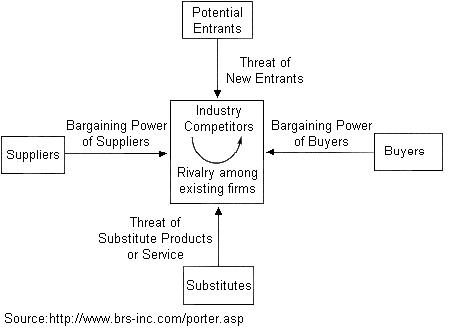Difference between revisions of "Competitive strategy (Porter)"
m (1 revision: Dump from York) |
|
(No difference)
| |
Revision as of 06:26, 28 September 2011
Theory of competitive strategy
Acronym
5 forces
Alternate name(s)
Five-forces model, Competitive forces, Porter's five forces, Porter's framework for competitive analysis
Main dependent construct(s)/factor(s)
Above normal profits
Main independent construct(s)/factor(s)
Main Constructs: • The bargaining power of customers • The bargaining power of suppliers • The threat of new entrants • The threat of substitute products • The intensity of competitive rivalry
Concise description of theory
Michael Porter's 1979 framework uses concepts developed in micro-economics to derive 5 forces that determine the attractiveness of a market. They consist of those forces close to a company that affect its ability to serve its customers and make a profit. A change in any of the forces requires a company to re-assess its marketplace.
Four forces -- the bargaining power of customers, the bargaining power of suppliers, the threat of new entrants, and the threat of substitute products -- combine with other variables to influence a fifth force, the level of competition in an industry.
This 5 forces analysis is just one part of the complete Porter strategic system. The other elements are strategic groups (also called strategic sets), the value chain, the generic strategies of cost leadership, differentiation, and focus, and the market positioning strategies of value based, needs based, and access based market positions.
Source: http://en.wikipedia.org/wiki/Five_competitive_forces
Diagram/schematic of theory
Originating author(s)
Michael E. Porter
Seminal articles
Porter, Michael E. 1979. How competitive forces shape strategy. Harvard business review, 57(2): 137-145.
Originating area
Economics, Strategic management
Level of analysis
Industry, Firm
IS articles that use the theory
Bharati, P. and Chaudhury, A. (2009), “SMEs and Competitiveness: The Role of Information Systems”, International Journal of E-Business Research, Vol. 5, No. 1, pp. i-ix.
Bharati, P. and Chaudhury, A. (2006), “Current Status of Technology Adoption: Micro, Small and Medium Manufacturing Firms in Boston”, Communications of the ACM, Vol. 49, No. 10, pp. 88-93.
Bharati, P. (2006), “Understanding the Future of Global Software Production: Investigating the Network in India,” in IFIP International Federation for Information Processing, Volume 214, The Past and Future of Information Systems: 1976-2000 and Beyond, Eds. Avison, D., Elliot, S., Krogstie, J. Pries-Heje, J., Springer, Boston, MA, pp. 119-129.
Bharati, P. (2005), “India’s IT Services Industry: A Comparative Analysis”, IEEE Computer, Vol. 38, No. 1, pp. 71-75.
Chakravarthy, Bala. 1997. A new strategy framework for coping with turbulence. Sloan management review, 38(2): 69.
Chen, Jason C., Chong, P. P., & Chen, Ye-Sho. 2001. Decision criteria consolidation: A theoretical foundation of pareto principle to porter's competitive forces. Journal of Organizational Computing & Electronic Commerce, 11(1): 1-14.
Chen, Ye-sho, Chong, P. P., & Chen, Jason C. 2000. Small business management: An it-based approach. Journal of Computer Information Systems, 41(2): 40.
Kim, K. K., & Michelman, Jeffrey E. 1990. An examination of factors for the strategic use of information systems in the health care industry. MIS Quarterly, 14(2): 201.
McFarlan, & Warren, F. 1984. Information technology changes the way you compete. Harvard business review, 62(3): 98.
Parsons, G. 1983. Information technology: A new competitive weapon.
Porter, Michael E. 2001. Strategy and the internet. Harvard business review, 79(3): 62.
Porter, Michael E., & Millar, Victor E. 1985. How information gives you competitive advantage. Harvard business review, 63(4): 149.
Rackoff, Nick, Wiseman, Charles, & Ullrich, Walter A. 1985. Information systems for competitive advantage: Implementation of a planning process. MIS Quarterly, 9(4): 285.
Links from this theory to other theories
Resource-based view of the firm, Knowledge-based theory of the firm
External links
http://www.investopedia.com/features/industryhandbook/porter.asp, A brief description of the theory
http://www.quickmba.com/strategy/porter.shtml, Detailed explanation about the model with some examples
http://www.mindtools.com/pages/article/newTMC_08.htm, A step to step guide for using the model for new learners
Original Contributor(s)
Hamid Akbari
Please feel free to make modifications to this site. In order to do so, you must register.
Return to Theories Used in IS Research
